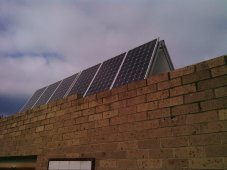Bluedog225
Texas
- Joined
- Nov 18, 2019
- Messages
- 2,893
I had the chance to sit, drink coffee, and watch the sun this weekend.
I’ve been thinking about how best to implement an east and west facing array (in addition to a main southern array) to fatten the curve of production and minimize hours on battery. None of this is built yet.
I focused on the east array and I ran a few scenarios through the PV Watts calculator. But only a few. It’s a bit of a pain on an ipad.
My hypothesis was that facing due east would not be the way to go given the weak early morning sun. And that a southeast array would pick up more power.
It looks like the south east array picks up 6.3% more watts at 10 am. There’s a tradeoff between picking up early morning sun earlier and giving up total production.
For me, picking up 1500 watts or so as early as I can and maintaining it until the southern array kicks in would allow me to run the air conditioner as early as possible. And for a couple of months a year, this can be important.
I’m still trying do decide how early is too early to point a few panels at the sun.
Someone smarter that me and handier with a computer could figure out how to graph production curves find the optimal azimuth and tilt to maximize morning production and allow the easterly facing array to ramp up and meet the southern array smoothly without a dip between the two. And similarly for the westerly array.
Anyway, I thought someone might find this interesting. Cheers.
I’ve been thinking about how best to implement an east and west facing array (in addition to a main southern array) to fatten the curve of production and minimize hours on battery. None of this is built yet.
I focused on the east array and I ran a few scenarios through the PV Watts calculator. But only a few. It’s a bit of a pain on an ipad.
My hypothesis was that facing due east would not be the way to go given the weak early morning sun. And that a southeast array would pick up more power.
It looks like the south east array picks up 6.3% more watts at 10 am. There’s a tradeoff between picking up early morning sun earlier and giving up total production.
For me, picking up 1500 watts or so as early as I can and maintaining it until the southern array kicks in would allow me to run the air conditioner as early as possible. And for a couple of months a year, this can be important.
I’m still trying do decide how early is too early to point a few panels at the sun.
Someone smarter that me and handier with a computer could figure out how to graph production curves find the optimal azimuth and tilt to maximize morning production and allow the easterly facing array to ramp up and meet the southern array smoothly without a dip between the two. And similarly for the westerly array.
Anyway, I thought someone might find this interesting. Cheers.



